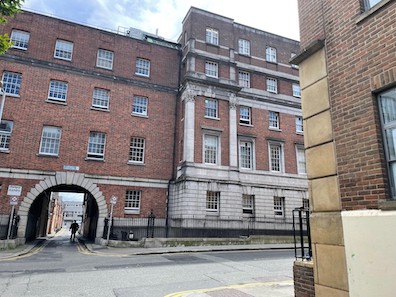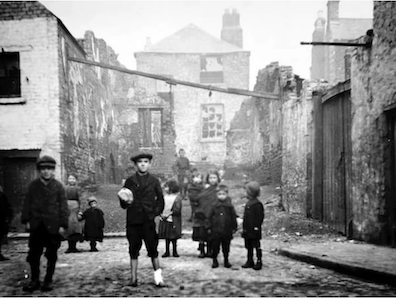The group of boys is raucous––one shouts out, "Jay, look at
the drunken minister coming out of the maternity hospal!" They
are also beggars: one asks for "A make, mister." Make
was slang for a halfpenny; according to Brewer's
Dictionary of Irish Phrase and Fable it was "universal
throughout Ireland" until the late 1960s. Someone in the group
of medical students reacts aggressively to the request––"Hell,
blast ye!"––and then someone else more quietly tells
them to be on their way: "Scoot." The gentler voice
seems to belongs to Bloom, because someone uses a typically
Jewish name to thank him for dismissing the beggars: "Righto,
Isaacs, shove em out of the bleeding limelight." And
then someone invites this helpful outsider to join their
company: "Yous join uz, dear sir? No hentrusion in life.
Lou heap good man. Allee samee dis bunch." The mongrel
slang, which appears to incorporate stereotypically Native
American ("heap"), Black American ("dis"), and Chinese
American ("allee samee") idioms into natively Irish ("Yous"),
and English lowlife talk, does not in any way obscure the
sense: Will you join us, kind sir? It would be no intrusion at
all. You're a very good man, and we're all alike here (your
Jewish heritage notwithstanding).
At the pub's closing hour the group
starts north toward Denzille Street, but then they
turn back the way they came ("Bout ship"), because one
of them hears
a fire engine to the south ("Mount street way")
roaring off to fight a blaze. At this point the group
threatens to break apart, and almost certainly does. The
person urging his companions to run up Holles Street to catch
a glimpse of the fire engine apparently fails to convince
everyone: "Tally ho. You not come? Run, skelter, race."
At least two of the group, Stephen and Lynch, turn off Holles
into Denzille Lane as an alternative route to the Westland Row
train station, where they plan to catch a train up to Monto: "Denzille
lane this way. Change here for Bawdyhouse." It makes
sense that Stephen would not want to run all the way to Mount
Street, given his advanced state of inebriation. It also
stands to reason that some of the medicals might want to
return to the hospital.
From the dialogue it appears that Stephen and Lynch are not
alone on Denzille Lane. As they jabber back and forth one of
them notices that they are being followed: "Whisper, who
the sooty hell's the johnny in the black duds? Hush! Sinned
against the light." This can only be Bloom, and in Circe
it becomes clear that he has followed Stephen all the way to
Nighttown. In Eumaeus Bloom reflects on "the very
unpleasant scene at Westland Row terminus when it
was perfectly evident that the other two, Mulligan, that is,
and that English tourist friend of his, who eventually euchred
their third companion, were patently trying as if the whole
bally station belonged to them to give Stephen the slip in the
confusion, which they did." Mulligan and Haines have arranged
to meet at Westland Row station, and the dialogue suggests
that Mulligan gets there by tagging along with Stephen and
Lynch: "Strike up a ballad. Then outspake medical Dick to
his comrade medical Davy." Once at the station, Mulligan
catches a train back to Sandycove with his English friend.
Gifford notes that "The Denzille lane boys" was "A
Dublin slang name for the Invincibles," the Fenian group who
committed the Phoenix Park murders on 6 May 1882. He does not
cite a source for this information, and I have not been able
to find any evidence of it, but the claim seems plausible. In
a personal communication Vincent Altman O'Connor recalls the
factional fighting waged throughout the 18th century by
violent gangs of poor young men in Dublin called the Liberty
Boys (Protestants who worked for weavers on the south side of
the river) and the Ormond Boys (Catholics from the north bank
who were butchers). In the years closer to the time of the
novel, various gangs in other countries sporting similar names
fought similar factional battles. Ike Clanton's Cowboys in
Arizona, represented in Wyatt Earp and the Cowboy War,
violently maintained the convictions of the old South in the
years after the Civil War. The Bowery Boys, represented in The
Gangs of New York, waged war on Catholics in New York
City. The Billy Boys of Glasgow, represented in Peaky
Blinders, did the same thing in the 1920s. It seems
possible that Catholic gangs in Dublin may have carried
similar names within Joyce's lifetime.
Dublin developed a militantly nationalistic Catholic
underworld in the years before and after the failed Fenian
revolt of the 1860s, and the roots it put down in the Denzille
area are many and deep. James Carey lived at 19A
Denzille Street, a street renamed Fenian Street after
independence, and the back door of his house fronted on
Denzille Lane. Altman O'Connor notes that according to the Dictionary
of Irish Biography James Fitzharris, a.k.a.
Skin-the-Goat, lived opposite Carey in Denzille Street "For a
time," and according to the census records he also lived at 2
Upper Erne Street, just north of Burke's pub. Knives used in
the Phoenix Park attack were discovered in a house that Carey
owned on nearby South Cumberland Street. In
Lotus Eaters Bloom thinks of Carey (or his brother
Peter, another Fenian) attending services every day at St.
Andrew's church, whose back door is on South Cumberland.
He also thinks of Meade's timberyard, surrounded
by "Ruins and tenements," at the bottom of that street. Its
owner employed Carey, and the two men were evidently close
because Carey transferred his assets to Meade prior to his
banishment from Ireland. Denzille Lane itself was full of
tenements––fertile breeding ground for revolutionary
sentiment.
Such history suggests that the impoverished "Denzille lane
boys" should perhaps be regarded as a living reminder of the
Invincibles, much as Bloom functions as a living reminder of
ancient Greek heroes.
(For more on the Liberty and Ormond Boys, listen to episode 4
of Donal Fallon's excellent podcast Three Castles Burning,
"Gangs of Old Dublin: Liberty Boys and Ormond Boys (with Cathy
Scuffil)" (2020), at threecastlesburning.libsyn.com. There is
also a book on the subject, The Liberty and Ormond Boys:
Factional riot in eighteenth-century Dublin (2005), by
James Kelly.)



